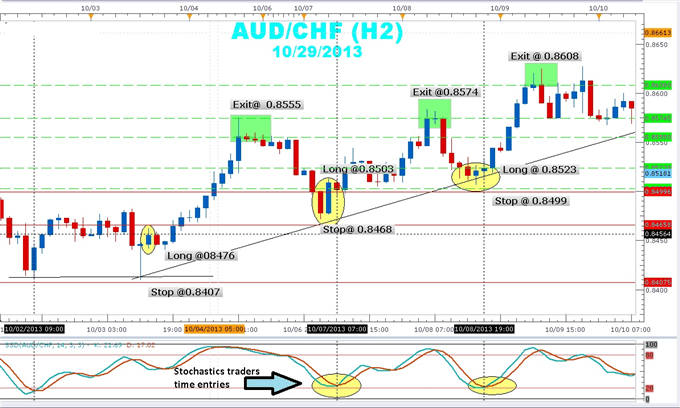Day Trade Entry talking points
- Buying at a discount involves waiting for price to pull back to level of support before entering
- Using an oscillator like Slow Stochastics with settings 14,3,3 can help traders time entries
- Traders may miss trades in a fast moving market waiting for the “discount” level, but this will enhance the risk to reward ratio over time
Whether you are investing real estate, stocks, businesses or trading Forex the wisdom of “buying low and selling high” is universal. Even comparison shopping for a pair of shoes, a car, or a box of cereal, people like getting a good deal paying less than the listed price.
However, when it comes to trading Forex, many traders who trade with the trend may end up buying much higher near the top of the range. Since the trader’s entry price is so far above a level of support, there is much more risk taken on the trade. If the trade moves against them, price has much farther to fall and will take much more time to get into the profit zone. This usually leads to certain loss as price begins to retrace and the trader is unable to handle a negative move. Traders jump into a fast moving market thinking that they will miss potential gains though price has moved a significant distance from an optimal entry point. Ironically, they lose the pips they were hoping to attain.
Learn Forex: AUD/CHF Long Entries near Trendline Support

The Solution
1. Only trade in the strongest currency pairs in the direction of the trend.
Traders will find the best low risk entries with the highest profit potential when they trade with the trend. Look for higher swing highs and higher swing lows with price moving in a stair step pattern. Draw a trend line connecting the swing lows from the lower left hand side of the chart rising to the upper right hand side of the chart
2. When the trend is up look to buy at or near the trend line with help of Stochastics
The closer you can buy to the trend line, the lower risk there is in the trade. Buying at or near the trend line enables a trader to place a stop, a few pips below the swing low. Chasing the market and allowing price to move too many pips from support increases the amount at risk while decreasing the amount of pips. Use an oscillator like Stochastics to pinpoint entries. When Stochastics moves down below 20 and rises back above 20 provides a buy signal confirming price action rebounding from the trend line.
3. Book profits that are at least twice the amount that you have at risk on the trade
Since the market moves in waves and does not move in a straight line, traders will want to take profits at the top of the range. This means that in an uptrend, traders should take profit just above the previous price high of the trend. In addition, traders who are short or trading in a downtrend will look to take profits just below the previous price low.
4. When currency pairs reverse and/or move into a range, stand aside.
Currency pairs range about 80% of the time, so if the trend becomes unclear and you have to ask your trading buddies the direction of the trend, you may need to look at other pairs for trading opportunities. If you only trade one or two currencies and both of them are not trending, then you may need to change up your strategies and use range trading strategies.
In Conclusion
Forex traders should enter trades in the direction of the trend on the strongest currency pairs. Traders can use a combination of trendlines and Slow Stochastic indicator with settings of 14,3,3 to pinpoint entries near the trend line support. Avoiding trading Forex pairs with unclear and ranging price action is a way of reducing account exposure to unfavorable trading conditions.
Appropriate stop placement near the trend line reduces risk while entries near the trend line maximize gain. Since the market moves in waves, taking profit near peaks in the range is a way of harvesting gains. Targeting a 1:2 risk to reward ratio puts the odds in your favor and reduces the number of times you need to be right in order to attain profitability.
Frequently Asked Questions (FAQS)
What are the best trading indicators?
There is no 'best' indicator in trading. Different indicators have different jobs and traders should use an indicator that they feel comfortable with and understand. An unique indicator is the Ichimoku indicator. It helps traders identify trends as well as entries and exits into the market. Entries and exits should be set to ensure a positive risk-reward ratio. At DailyFX we analzyed millions of live trades and came to the striking conclusion that traders using a positive risk-reward ratio were more likely to be successful.




